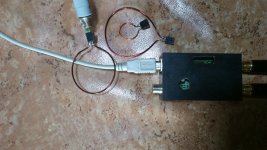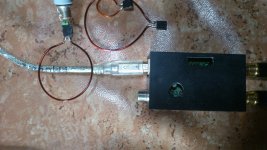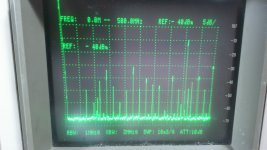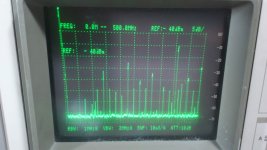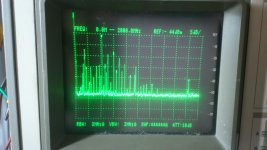Thanks for expounding mate; I understand your point better. It is interesting to consider the variance caused by changing cabling vs. appropriate isolation/reclocking. I'd appreciate joro or anyone else with a deeper understanding of the digital domain chiming in.
I went back and rolled a few cables with another DAC that's using an Amanero/Acko combination; didn't hear any marked difference with that DAC, or with Joro's. Subjective stuff for sure.
I went back and rolled a few cables with another DAC that's using an Amanero/Acko combination; didn't hear any marked difference with that DAC, or with Joro's. Subjective stuff for sure.
Hi,
There is an industry that deals with the study of the cables and their production, prices of good cables are not pleasant enough. At the end of my post I’ll make an additional explanation about the cables.
I think that you aren’t squeeze the maximum of the interface and therefore your conclusion is that. On your tests up to now, you only use the S / PDIF output. At all listen sessions that I've done with my friends with different receivers (the stock ones and DIY), S/PDIF is significantly lower in sound quality (not only my IF, but with others too). Using the S/PDIF output, you add other variables that complicate the task for the high quality sound and lead to wrong conclusions "where is the key for the treasure". However if you mainly use the S/PDIF output, you can change the output transformer DA101C with Newava transformer. Some people like Newava transformer more than DA101C. The one compromise, which is made by conscious is regarding the oscillators, but the two Crystek oscillator, which I think are good enough cost almost as the entire device Crystek 1 and Crystek 2 that’s why there is an input for an external clock. I plan a board which will be daughter one, on which one can choose quality oscillators for those who want to squeeze the maximum out of this interface. This compromise is made, so the device can be more accessible and squeezing the maximum from it, is very easy
that’s why there is an input for an external clock. I plan a board which will be daughter one, on which one can choose quality oscillators for those who want to squeeze the maximum out of this interface. This compromise is made, so the device can be more accessible and squeezing the maximum from it, is very easy 
I think you misunderstood the purpose of galvanic isolation and reclock. I won’t go into details, but the main task of galvanic isolation is to prevent ground loop with the PC and to reduce the noise from PC, and the reclock is to remove the jitter imported by the galvanic isolation IC. I can assure you that the efficiency of the use of both is proven with many listening tests (one of the first versions of the device was without the galvanic isolation and the reclock ). If there was no benefit from them, I would not use them
). If there was no benefit from them, I would not use them  . In this case there is a correlation between listening tests and measurements.
. In this case there is a correlation between listening tests and measurements.
The device is left "open" so that every DIY-er could squeeze as much as he needs. In the form in which the interface is given, it meets 95% of the audience, the rest can care to squeeze the maxim of transport. One must not to forget that this is part of a whole system providing the transport of the audio and it’s not a final product, but one that is intended to be finished by DIY-ers. The co-ordination / suitance of the interface to the external environment is of great importance.
I wish this kind of world, but unfortunately I do not think it is easy and affordable to achieve.
I'm back for the USB cables you noticed that have influence. Each cable (not only the USB ones) has its own broadcasting / emission depending on their design and the materials which are made from (as you will see from one of the spectrograms the emission of the cable is up to 1GHz). Pictures below are for two different USB cables and I intentionally use PCM2706. The emission is visible with the measurement done by my “old friend” ANRITSU MS710, which soon will come into well-deserved rest .
.
If you look close at the pictures, you will notice the differences in their emissions. To be placed under the same conditions the input signal is 1kHz sin. You would probably guess that the galvanic barrier is the cables’ isolation and air. I hope that it becomes clear that the galvanic isolation is not a panacea, for me personally its usefulness is undeniable.
The electromagnetic interferences of the cables are received by each wire (trace from a PCB board) in free space as the distance is less, so the impact is greater. The only struggle with the electromagnetic field is with electromagnetic screens.
Regards,
Joro
...
The interface needs a physically well done USB connection. Slightest changes (cable/ground etc.) can make a huge difference...
...Basically with this interface you'll never know where you're at. Your tweaking might never end. And that'll cost you time and extra money, without knowing where you're heading...
There is an industry that deals with the study of the cables and their production, prices of good cables are not pleasant enough. At the end of my post I’ll make an additional explanation about the cables.
I think that you aren’t squeeze the maximum of the interface and therefore your conclusion is that. On your tests up to now, you only use the S / PDIF output. At all listen sessions that I've done with my friends with different receivers (the stock ones and DIY), S/PDIF is significantly lower in sound quality (not only my IF, but with others too). Using the S/PDIF output, you add other variables that complicate the task for the high quality sound and lead to wrong conclusions "where is the key for the treasure". However if you mainly use the S/PDIF output, you can change the output transformer DA101C with Newava transformer. Some people like Newava transformer more than DA101C. The one compromise, which is made by conscious is regarding the oscillators, but the two Crystek oscillator, which I think are good enough cost almost as the entire device Crystek 1 and Crystek 2
Joro's intention with all the efforts he puts into the project by isolating and reclocking, using asynchronous USB with one of the best interface chips, asf clearly outlines his target.
If slightest variations of a digital data stream or the physical conditions (EMI/RFI/jitter/noise) on the input section still show up at the output, my guess would be that he missed his own target.
It would just show the inefficiency of his isolating and reclocking measures. At least to a certain extent...
I think you misunderstood the purpose of galvanic isolation and reclock. I won’t go into details, but the main task of galvanic isolation is to prevent ground loop with the PC and to reduce the noise from PC, and the reclock is to remove the jitter imported by the galvanic isolation IC. I can assure you that the efficiency of the use of both is proven with many listening tests (one of the first versions of the device was without the galvanic isolation and the reclock
...
In my opinion he also has to make sure to achieve very stabil conditions, by properly cleaning up (buffering and filtering) the incoming PS voltages/currents. He even allows USB power for the input section. Obviously he is convinced that his efforts on the isolated side are more then sufficient to cope with the surrounding conditions.
...
The device is left "open" so that every DIY-er could squeeze as much as he needs. In the form in which the interface is given, it meets 95% of the audience, the rest can care to squeeze the maxim of transport. One must not to forget that this is part of a whole system providing the transport of the audio and it’s not a final product, but one that is intended to be finished by DIY-ers. The co-ordination / suitance of the interface to the external environment is of great importance.
...
In a perfect world, me as a user, would like to end up with the same consistently high soundquality, doesn't matter what USB capable transport we're talking about...
I wish this kind of world, but unfortunately I do not think it is easy and affordable to achieve.
I'm back for the USB cables you noticed that have influence. Each cable (not only the USB ones) has its own broadcasting / emission depending on their design and the materials which are made from (as you will see from one of the spectrograms the emission of the cable is up to 1GHz). Pictures below are for two different USB cables and I intentionally use PCM2706. The emission is visible with the measurement done by my “old friend” ANRITSU MS710, which soon will come into well-deserved rest
If you look close at the pictures, you will notice the differences in their emissions. To be placed under the same conditions the input signal is 1kHz sin. You would probably guess that the galvanic barrier is the cables’ isolation and air. I hope that it becomes clear that the galvanic isolation is not a panacea, for me personally its usefulness is undeniable.
The electromagnetic interferences of the cables are received by each wire (trace from a PCB board) in free space as the distance is less, so the impact is greater. The only struggle with the electromagnetic field is with electromagnetic screens.
Regards,
Joro
Attachments
Hi Joro,
Do you have a timeline for when the enhanced clock daughterboard will be released? I'm mighty interested in that.
Also, I have your AK4396 board already purchased, but if you were to somehow develop a DAC based on the PCM1704 chip, I have a feeling I'd be digging into my pockets once again. It doesn't even need to have the I/V stage onwards as those can be covered by other projects within this forum, IMO.
It doesn't even need to have the I/V stage onwards as those can be covered by other projects within this forum, IMO.
Do you have a timeline for when the enhanced clock daughterboard will be released? I'm mighty interested in that.
Also, I have your AK4396 board already purchased, but if you were to somehow develop a DAC based on the PCM1704 chip, I have a feeling I'd be digging into my pockets once again.
Hi,
*snip*
The one compromise, which is made by conscious is regarding the oscillators, but the two Crystek oscillator, which I think are good enough cost almost as the entire device Crystek 1 and Crystek 2that’s why there is an input for an external clock. I plan a board which will be daughter one, on which one can choose quality oscillators for those who want to squeeze the maximum out of this interface. This compromise is made, so the device can be more accessible and squeezing the maximum from it, is very easy
*snip*
Hi Joro.
I'm well aware a EMI and other distortions. I do also have quite an understanding
of discussed and underlying problems.
As somebody mentioned earlier the board "scales" with the distortions.
He figured that it would be a good thing.
Obviously we're not in the analog world. "Scaling" of a digital interface I'd call "Quality issue"
That's what I'm saying. All windows and doors are wide open.
But at least some solid walls should be built in.
I'm well aware a EMI and other distortions. I do also have quite an understanding
of discussed and underlying problems.
As somebody mentioned earlier the board "scales" with the distortions.
He figured that it would be a good thing.
Obviously we're not in the analog world. "Scaling" of a digital interface I'd call "Quality issue"
...the device is left open...
That's what I'm saying. All windows and doors are wide open.
But at least some solid walls should be built in.
But what are you talking about? It is obvious that some compromise should be made anyway in projecting an electronic device, say in price, dimensions, etc..
Joro's interface is a VERY GOOD compromise upon me, but you can't claim maximum sound quality by a 100€ device that rest in the palm of an hand.
Joro was very good in projecting a device that any diyer searching for more sound quality can improve with little effort and a small amount of money, so that's absolutely OK for me. If you want hi-end devices, i think you can find them on sale, but you'll have to pay more as they will include a really good power management to sound good - as Joro's interface needs as well to give its better.
Maybe you know about a better sounding interface for this price? If you do, just tell us! But if you don't, what are you arguing about?
Joro's interface is a VERY GOOD compromise upon me, but you can't claim maximum sound quality by a 100€ device that rest in the palm of an hand.
Joro was very good in projecting a device that any diyer searching for more sound quality can improve with little effort and a small amount of money, so that's absolutely OK for me. If you want hi-end devices, i think you can find them on sale, but you'll have to pay more as they will include a really good power management to sound good - as Joro's interface needs as well to give its better.
Maybe you know about a better sounding interface for this price? If you do, just tell us! But if you don't, what are you arguing about?
Guys - soundcheck shared his views, I, Joro and others responded. Let's not escalate this. Value will always be subjective; some (myself included) find this 'kit' to be a very good value - others will find it less so. Some will be happy with the provided features, others with wish for/want more.
No need for this to degrade and become heated; there's no value in that at all.
No need for this to degrade and become heated; there's no value in that at all.
MisterRogers is right, value is a relative thing!
For me, Joro's combo has an excellent price/performance ratio.
I've came to learn that past a certain level, everything has an influence in the final sound, even we don't like or don't want to admit it ! I have yet to see a true high-end CD player/DAC that it is not influenced by the power cords, interconnects, the surface underneath it, and some objects placed on it . Can we say that all of them are poorly engineered? (tested personally on 2 EmmLabs combos, Meridian 808.1 and 808.3, Chord Red reference and Violet and several other). I don't like it either, but it's reality!
For me, Joro's combo has an excellent price/performance ratio.
I've came to learn that past a certain level, everything has an influence in the final sound, even we don't like or don't want to admit it ! I have yet to see a true high-end CD player/DAC that it is not influenced by the power cords, interconnects, the surface underneath it, and some objects placed on it . Can we say that all of them are poorly engineered? (tested personally on 2 EmmLabs combos, Meridian 808.1 and 808.3, Chord Red reference and Violet and several other). I don't like it either, but it's reality!
Guys - soundcheck shared his views, I, Joro and others responded. Let's not escalate this. Value will always be subjective; some (myself included) find this 'kit' to be a very good value - others will find it less so. Some will be happy with the provided features, others with wish for/want more.
No need for this to degrade and become heated; there's no value in that at all.
OK, sorry. I think Soundcheck point of view is clearly evident now - but i think it's a strange point of view in a diy forum.
Anyway, let's hope Joro can use Soundcheck advices to make its interface better!
I plan a board which will be daughter one, on which one can choose quality oscillators for those who want to squeeze the maximum out of this interface.
Looking forward for the daughter board
High quality oscillator is a must for digital audio.
... but the main task of galvanic isolation is to prevent ground loop with the PC and to reduce the noise from PC ...
PC is a very polluted component noise wise and not purposely built for audio.
Add to that equation a necessity of a pc monitor/TV.
Galvanic or any other kind of isolation is a must for this context IMHO.
So, one integrated cd player as a source equals pc monitor + PC + DAC.
Not an easy task for the later combination.
Did I mention an additional interface (sata, usb) cables?
Last edited:
but i think it's a strange point of view in a diy forum.
What's a strange point of view here !??!
We discuss quality of caps, resistors, cables. What's so strange to discuss the quality of boards???
DIY knows different levels. Most of it nowadays equals "Painting by Numbers" (PbN).
Todays highly integrated boards leave close to no space for tweaking.
If the base design comes with flaws... ...bad luck. You might try the next revision.
Boards are piling up in my workshop.
Joros board is a commercial board. With all the add-ons it easily approaches a Audio-GD DI or a Dragonfly 1.2 from a cost side - and these devices are Plug'n Play.
For me the price is no reason to go for Joros board. The chinese DIY competition is not sleeping either when it comes to average boards..
And please consider:
The issue with DIY boards and parts: Have your ever tried to return or sell a board?? I can easily sell a Dragonfly.
Another comment:
I'm pretty sure that it won't help to hook up an even better clock, if the base design is kind of weak.
Joro shoud rather concentrate on reworking and improving decoupling/filtering/reclocking and also introduce a plop-less design.
Further comment:
Beside that I think it is a bad idea to ask for a 7.5V-9V power supply for the PCM5102 board. It makes the hole thing much more difficult to handle since most quality PS
for us "PbN" Diyer are 5V or 3.3V.
If anybody still wants a 2 weeks old board with PCM5102 at 40% below original price. Please PM me. As I said. If you hook up two batteries and play a little with the
USB cable and transport it easily competes with a battery driven Audiophilleo.
Cheers
Last edited:
I'm not so experienced in DIY, neither in DIY communities, but I find soundcheck's point of view is interesting.
I can't evaluate it technically, but I really like Joro's board - hooked with a battery, the AKM is really entertaining. I couldn't find a similar board (trasport+DAC I mean) with DSD at the same price.
I need the say, In Italy most "brands" like Dragonfly or AudioGD are almost un-resellable if not at a very low price, just a bit more than DIY boards, even if are PnP ("finished product", as we say); this happens just 'cause they are... too much Chinese, "exotic" someway. It's just a sort of mood, I think, my DI-V3s serves a Beresford Bushmaster (UK styled, China made) as no other USB-powered transport can do, so quality is not in doubt.
So, pricewise, they are quite the same.
I can't evaluate it technically, but I really like Joro's board - hooked with a battery, the AKM is really entertaining. I couldn't find a similar board (trasport+DAC I mean) with DSD at the same price.
I need the say, In Italy most "brands" like Dragonfly or AudioGD are almost un-resellable if not at a very low price, just a bit more than DIY boards, even if are PnP ("finished product", as we say); this happens just 'cause they are... too much Chinese, "exotic" someway. It's just a sort of mood, I think, my DI-V3s serves a Beresford Bushmaster (UK styled, China made) as no other USB-powered transport can do, so quality is not in doubt.
So, pricewise, they are quite the same.
Well...
I have to say a few things.
First of all, the starter of this thread offers a product with well explained and documented features.
From the 3rd June 2013 everyone could see a few photos that are quite illustrative of what one could expect to get and what is the potential for further tweaking.
Joro was and still is a kind person who generously share both the information and his knowledge in this context.
Does this product satisfies our expectations is up to us to decide but I wouldn't say anything against this product as long as it works as advertised.
Joro has never mentioned that he is offering a hi end product.
I decided to by his combo (XMOS/AKM) as my first entry into pc audio just to get a picture and decide should I step into this area abandoning a cd player as the source component.
The XMOS board is extremely compact so the possibilities for further tweaking, besides the better oscillators, are indeed very limited.
Being such a compact product I see it as an advantage.
AKM dac board is also very compact but I shall try a few tweaks and share them if they show as an improvement.
I have to say a few things.
First of all, the starter of this thread offers a product with well explained and documented features.
From the 3rd June 2013 everyone could see a few photos that are quite illustrative of what one could expect to get and what is the potential for further tweaking.
Joro was and still is a kind person who generously share both the information and his knowledge in this context.
Does this product satisfies our expectations is up to us to decide but I wouldn't say anything against this product as long as it works as advertised.
Joro has never mentioned that he is offering a hi end product.
I decided to by his combo (XMOS/AKM) as my first entry into pc audio just to get a picture and decide should I step into this area abandoning a cd player as the source component.
The XMOS board is extremely compact so the possibilities for further tweaking, besides the better oscillators, are indeed very limited.
Being such a compact product I see it as an advantage.
AKM dac board is also very compact but I shall try a few tweaks and share them if they show as an improvement.
What's a strange point of view here !??!
We discuss quality of caps, resistors, cables. What's so strange to discuss the quality of boards???
DIY knows different levels. Most of it nowadays equals "Painting by Numbers" (PbN).
Todays highly integrated boards leave close to no space for tweaking.
If the base design comes with flaws... ...bad luck. You might try the next revision.
Boards are piling up in my workshop.
Joros board is a commercial board. With all the add-ons it easily approaches a Audio-GD DI or a Dragonfly 1.2 from a cost side - and these devices are Plug'n Play.
For me the price is no reason to go for Joros board. The chinese DIY competition is not sleeping either when it comes to average boards..
And please consider:
The issue with DIY boards and parts: Have your ever tried to return or sell a board?? I can easily sell a Dragonfly.
Another comment:
I'm pretty sure that it won't help to hook up an even better clock, if the base design is kind of weak.
Joro shoud rather concentrate on reworking and improving decoupling/filtering/reclocking and also introduce a plop-less design.
Further comment:
Beside that I think it is a bad idea to ask for a 7.5V-9V power supply for the PCM5102 board. It makes the hole thing much more difficult to handle since most quality PS
for us "PbN" Diyer are 5V or 3.3V.
If anybody still wants a 2 weeks old board with PCM5102 at 40% below original price. Please PM me. As I said. If you hook up two batteries and play a little with the
USB cable and transport it easily competes with a battery driven Audiophilleo.
Cheers
Weren't we asked to avoid heating up and spitting judgements based upon personal opinions?
I just found strange to hear so much problems in building a good quality DAC using good quality power supply/subsidiary components, in a diy forum. We're not talking about commercial, plug'n'play products, but about components for custom diy projects.
Audio GD DI is probably a good quality product, but i think its quality relies heavily on the quality of the PSU and other subsidiary components just as much as Joro's interface does - this i can understand reading Audio GD own site - that is nothing new for any audio diyer. It makes no big difference to me if Audio GD itself manufacture those components And i don't think sound quality of a hi-end DAC based on a well implemented Joro's interface is lower than that of one based on a well implemented Audio GD DI...
Anyway, as you say, Joro's XMOS interface is a commercial board, not a commercial finished DAC: it's up on diyers to build a proper filtering/rectifying/transforming section to make it sound as good as they can/want.
Said there, i agree on the statement about PCM5102 tension request, it makes more difficult to properly implement a finished DAC. But i think Joro is now focusing in better sounding DAC boards, isn't it?
More, i think it would be a good idea for Joro to offer some higher quality yet small power supply boards designed to feed his DAC/XMOS boards, just to make things easier for beginner diyers (and as Audio GD does): LM317 are not up to today hifi standards and to XMOS/AK4396 potentials, in my opinion.
Last edited:
Compact ?? You forget the external power supplies required to drive the board - if you intend to enjoy high quality performance.
Compact I consider Hiface DAC or Dragonfly etc..
Beside that I'd rather accept a square inch more in size, then accepting compromises on decoupling, clocks, filtering etc.
And again. I do not intend to discredit Joro or his company or his product.
He offers a rather interesting product and puts a rather fair pricetag on it.
That's was the reason why I bought it.
I gave similar feedback to HifiMeDIY about their DDX320 fulldigital amp over here @ DIYA.
And guess what!?!? They listened. Meanwhile they have implemented many of my suggestions.
Cheers
Compact I consider Hiface DAC or Dragonfly etc..
Beside that I'd rather accept a square inch more in size, then accepting compromises on decoupling, clocks, filtering etc.
And again. I do not intend to discredit Joro or his company or his product.
He offers a rather interesting product and puts a rather fair pricetag on it.
That's was the reason why I bought it.
I gave similar feedback to HifiMeDIY about their DDX320 fulldigital amp over here @ DIYA.
And guess what!?!? They listened. Meanwhile they have implemented many of my suggestions.
Cheers
- Status
- This old topic is closed. If you want to reopen this topic, contact a moderator using the "Report Post" button.
- Home
- Source & Line
- Digital Line Level
- XMOS DSD 384 kHz / 32bit USB
